So CJ and I hopped on the train and then a subway to the north east side of Tokyo in Ryogoku. There we entered the The National SUMO Stadium "Kokugikan" to watch a days full of matches with boys and men of all sizes and shapes push and shove each other over the raised straw line to a quick victory.
For those of you that don't know how SUMO works I will try to give you a hopefully quick lesson on the rituals and order of the day. Of if you want a quick and concise version check out this website. IThis is a great web page with a ton of information. I highly recommend it.
http://www.sumo.or.jp/eng/
We of course arrived later than we anticipated, with all the craziness that came with the messages from the night before and so we by passed visiting the Sumo museum. We can always go back another day after the tournament "basho" is over, and visit the stables "beya" too, where you can silently watch the training taking place from 5:30am-10am with an appointment. Fun!
It is a bit silly they are not open after the matches we thought, as we would have visited then, but we really wanted to get inside and see what was going on with the actual bouts taking place up close and personal right before our very own eyes.
When you go early in the day you can sit wherever you want until someone comes to claim their ticketed seat, and so CJ and I of course bee lined to the front and center area of the "in the round" style auditorium. I actually sat further back than I could have in the cheaper box seats as I wanted a place to drape my legs on one of the tiered bench seats. I knew I could not sit in the more expensive boxed off area "masu" seats where you sit "Indian style" or "Geisha style" on my knees on a purple cushion "zabuton" for the whole day if I actually planned to walk out of there on my own power. I don't get how people can do that, my legs just do not do that anymore. Numbness sets in way to quickly for me and my legs feel like cement tree trunks. I get enough of that when I sit way to long at my computer :-)
I also saw on TV a few days before, how those BIG BOYS sometimes fall into the first 3 rows of spectators and so I did not want to be crushed by one of them, with their 100kg (220lb)+ bodies, nor to feel their naked rolls of sweaty muscle and unsightly,cellulite,hairy,bruised and beaten flesh come in contact with mine. :-?
Sumo has 6 Divisions-- 4 lower ones and 2 upper ones Juryo and the top Maku-uchi. The top 2 groups fight at night from 4-6pm. Those bouts are on TV as well and that is when the place is full if all ticket holders show up. So from 830am-300pm or so you really can sit up close, and it is very cool and fun to be right in the thick of the action.
So the young boys or new recruits wrestle in the ring "dohyo" for the first time in a test competition called "maezumo". Some are right out of high school or college and you can tell, because they still have their short crew cut hair styles. We were too late and did not see any of these fight but we did see 3 of them with their ceremonial aprons come out for some type of recognition. They wrestle first thing in the morning starting at 8:00am.
At 8:35 the Jonokuchi-Makushita divisions wrestle. These are 2 of the 4 bottom "trainee" divisions which compete for 7 out of the 15 days of the tournament. On any given day, approx 1/2 of these men in the 4 divisions will compete. The trainees who complete this process, then earn the right to have their names appear on the "Banzuke" or offical listing of rank for the next tournament.
Their are 6 major tournaments "sumo basho" a year Jan,May and Sept in Tokyo, March in Osaka, July in Nagoya and Nov in Fukukoa.
At 2:30 in the afternoon the Juryo Division enters the ring and they have their Ring Entering ceremony "doyo-iri" where the wrestlers from the west all enter down one aisle in reverse order of their rank with their heavily embroidered ceremonial aprons "kesho-mawashi" on and climb up onto the dohyo and circle the ring. These aprons are made of beautiful silks with richly embroidered designs and hemmed with gold fringe,costing anywhere from 400,000-500,000yen ($4,000-$5,000). When they are all up there in a circle they go through a short ritual and then depart before the east rikishi enter from the other side and do the same thing.
The leading roles in the dohyo-iri ceremony are reserved for the YOKOZUNA top rikishi in the west and east. The YOKOZUNA from each side do their own individual ceremony after their division peers do theirs. He comes down the aisle attended by a senior referee "gyoji" and 2 other rikishi in aprons from his division and gets in the ring and does the ceremonial rituals. The YOKUZUNA also wears over his other apron a massive braided hemp rope weighing 25-35 pounds tied in the bow at the back and ornamented in the front with zig-zag strips of paper representing lightning. This is a familiar religious symbol in the front of all Shinto Shrines and in houses at New Years hanging from the shelf where they make offerings to the gods. The shinto style roof "tsuriyane" that hangs over the dohyo too has colored tassels at each corner representing the 4 seasons of the year- white, red, green and black.
Their individual bouts then take place and since there are no weight requirements like in western wrestling or boxing it is possible for wrestlers "rikishi" to be pitted against an opponent twice his own weight. We did see that and a few times the "little" guy actually won the bout.
A bout is won by forcing the opponent out of the inner circle or throwing him into the dohyo. You don't have to fall in or completely out of the circle to lose the match either. The rikishi whose body part touches the ground first loses. That could be with a finger, toe, knee, hand, elbow, top knot of the hair inside the ring...Or the first toe or heel out over the straw ring loses as well. There is no hitting with fists,(they can and do slap), hair pulling, eye gouging, kicking in the stomach or chest permitted and it is also against the rules to sieze the part of the band covering the vital organs. They can pull on the other part of the G string or "mawashi" .
The rikishi when wrestling are naked except for this silken loincloth which is made of a piece of silk approximately 10 yards long by 2 foot wide folded in 6ths and then wrapped around the waist 4-7 times depending on the girth of the man. This is a fundamental part of the equipment as 70 of the winning tricks are acheived by maneuvering the opponent with a grip on his Mawashi. The strings which hang from the front are silk stiffened with glue and they are only ornamental and often times thrown away.
So an individual bout begins by the "yogoshi" they are the group that usher spectators to their seats, build the actual ring with straw hay bales, clay and sand before the tourney begins, sweep the salt from the dohyo between each bout, work the corners during the tournament.... He steps into the center ring and facing the west first he opens a folded fan and calls out in a chant like voice which echos through the stadium especially early in the day when the place is half empty ...the west, name of rikishi, beya he is from, then he turns to the east as says the same about that eastern rikishi.
Then the 2 rikishi and the gyoji enter the ring,for the "shikiri" and go through a series of symbolic movements. While they busy doing that the gyoji then says again in a chant like voice the two opponents names and east/west. They bow and face the middle and then do a couple of leg lifts to stamp out the evil spirits, squat in "get set" position like a football center and glare at each other, before moving back to their respective corners. There they get a cup of water from the previous bout winner or rikishi to fight after them depending on what side they are on... so to cleanse their minds and bodies by rinsing their mouths with water the source of purity and then wiping with a paper towel. The rikishis come back to the center and squat again and do hand claps in front of them and up above their heads to show they are weaponless and their hands are empty.
Then they squat again in the middle and then back to their corners and this time they wipe their faces, underarms chests with a towel and then grab a handful of salt to throw in the ring to purify it and also help insure and prevent against injuries. The salt throwing is the privilege only of the 2 high divisions "Maku-uchi", "Juryo" and "Maku-shita" rikishi. They come back to center and squat again and glare some more. They may get up one more time and go back to the corner to get more salt, psyche themselves up by face, leg, chest, mawashi slapping to rid the hands of salt before returning to actually fight.
The Maku-uchi have 4 minutes to do this, the Juryo 3 minutes and the lowest rank comes in and must begin to wrestle right away. This is building up and getting their psychi ready and the crowd excited. Then the match begins with them in the get set position and the first one to touch down in the center or step out of the ring loses. The actual wrestling is over in a matter of seconds usually. After the bout, they both stand in the ring bow once more and the loser leaves and the winner squats and the gyoji chants winner and the rikishi does some hand movement to acknowledge he won grabs his paper and steps down out of the dohyo. He hands his paper to the corner yogoshi who ties it up with his fringe ornament and towel and then he waits to pass the water cup to the next guy. On the losers side the wrestler in the 2nd bout to come comes and gives water to the new opponent.
About 3:30pm or so and after the Juryo division is done there is another ring ceremony with all the highest ranked Maku-uchi Division rikishis in their aprons. Rikishi on the east side of the Banzuke perform first on odd numbered days and ones on the west fight first on even numbered days. These are sumo's elite men and they are fighting for The Emperors Cup. Which is given to the rikishi with the best record after the last match of the last day of the tournament. They also give out special awards for performance, fighting spirit and technique.
Each day after the matches are complete their is a bow ceremony around 6:00pm. A designated rikishi from the Mauku-shita division performs the colorful bow ceremony. This is to symbolize the gratitude felt by the day's victors. Then they cover the dohyo for the next day with a canvas cloth. The spectators also toss the purple seats cushions down onto the ring after the last match ends or maybe it is when they are unhappy with the winning decision?? I saw it on TV and it happened when we were there 2 times. So it could be for both reasons?
All in all it was an enjoyable day and very interesting. I met a lady Lindy from New York who was there and she gave me alot of information I did not get from the above website. She was an engineer for Corningware and used to live here for 2 years and was back on business. I too met and had my picture taken with one of the rikishi', but I have no idea who he was and I could not tell when he was in the ring? He did sign my notebook, so I will have to ask my sensai what he wrote.
I must say, I like the more fit and athletic looking men, it seems like a much healthier sport too when they are strongand muscular and not so fat.
I found it very interesting at the end how they all just walk out of the stadium and into the streets to stroll home in their colorful yukata robes and flip flops with umbrella in hand if needed and with no entourage or body guards helping them move the masses to get back safely and without harm to their respective beya. I don't think that would ever happen in the USA...again there is that respect for personal space. Cool!
Back on the train and subway through Yokohama for a Jumbo-cho of course and then home to catch the highlights on TV.
Monday, September 22, 2008
Subscribe to:
Post Comments (Atom)






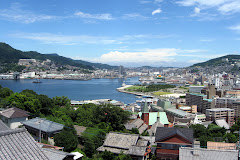





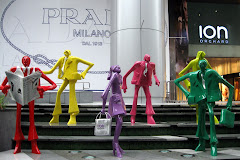























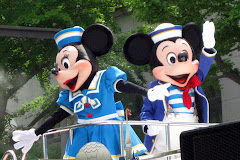














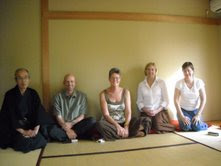

























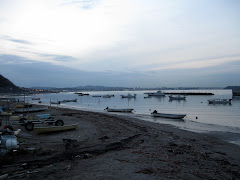


















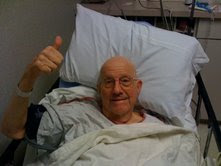
























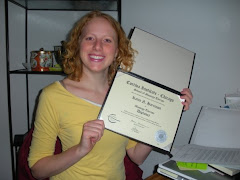










































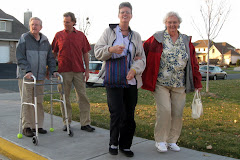





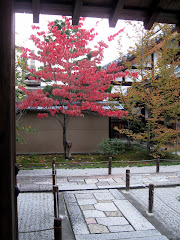







































































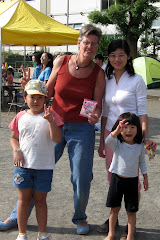











































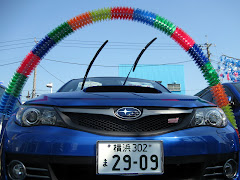















































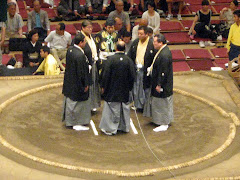














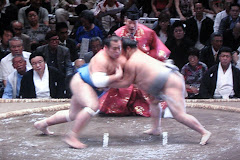













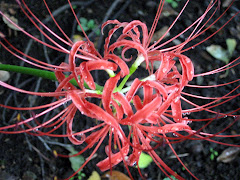



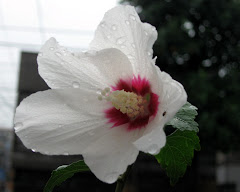









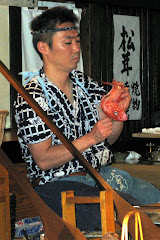








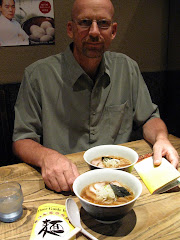








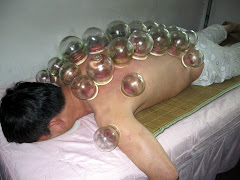

































































































































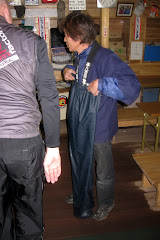





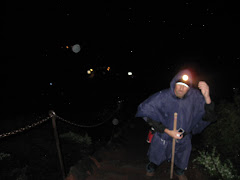









































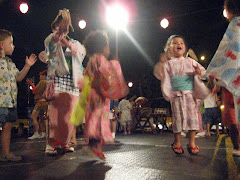




















































































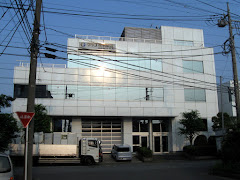





































































































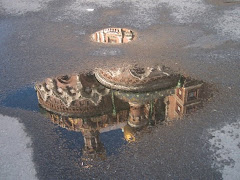













































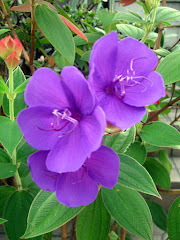














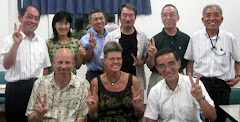



















































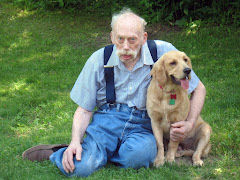
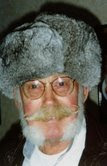
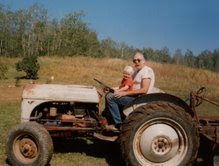
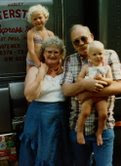



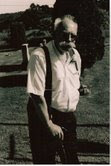






































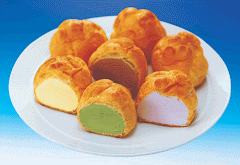

















































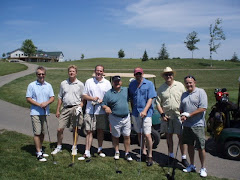














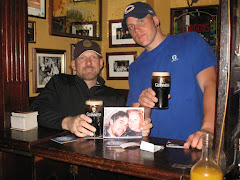


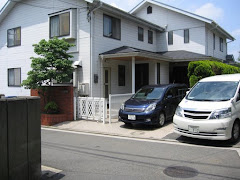
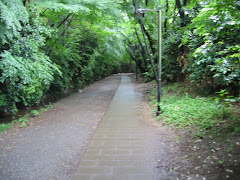
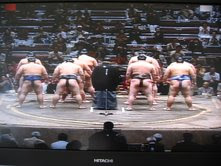
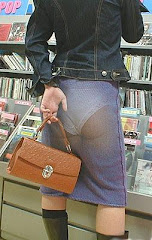


No comments:
Post a Comment